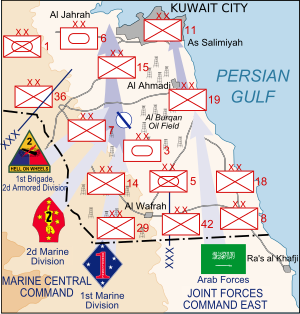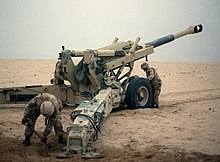| Battle of Kuwait International Airport | |||||||
|---|---|---|---|---|---|---|---|
| Part of the Persian Gulf War | |||||||
 The "heel" of Kuwait | |||||||
| |||||||
| Belligerents | |||||||
|
|
| ||||||
| Commanders and leaders | |||||||
|
Maj. Gen. Myatt[1] Colonel Fulford Jr[1] |
Maj. Gen. Mahmoud Gen. Hamdani[2] | ||||||
| Units involved | |||||||
|
1st Marine Division 2nd Marine Division Bravo Company, 4th Tank Battalion, 4th Marine Division 2nd Armored Division's Tiger Brigade 3-41 Infantry's Straight and Stalwart Battalion Task Force United States Army Special Forces[1] |
3rd Armored Division[3] 5th Mechanized Division 1st Mechanized Division 6th Armored Division 7th Infantry Division 8th Infantry Division 11th Infantry Division 14th Infantry Division 29th Infantry Division 15th Infantry Division 18th Infantry Division 19th Infantry Division 36th Infantry Division 42nd Infantry Division 449th Field Artillery Brigade[4] Multiple Commando Units | ||||||
| Casualties and losses | |||||||
|
19 killed 48 wounded 1 M1A1 tank damaged[5] 10 M60A1 tanks destroyed/damaged[6] |
Heavy casualties Thousands captured Hundreds of Iraqi tanks and armored personnel carriers destroyed or captured[7][8][9] | ||||||
| 1 British Airways Boeing 747-100 destroyed | |||||||




The Battle of Kuwait International Airport occurred on February 27, 1991, during the 1st Gulf War. It was a tank battle between the United States (as part of the Coalition of the Gulf War) and Iraq. Despite being a very large battle it is often overlooked compared to the other battles which took place during the war. No less than elements of 18 divisions total participated in this battle. US Army Special Forces units and multiple Iraqi Commando units were also in theatre. In reality the battle took place over a span of three days despite the primary battle at Kuwait International Airport lasting only one day. Much of the combat actually took place en route to the airport. The battle featured the "Reveille Engagement" which went on to become the biggest and fastest tank battle in United States Marine Corps' entire history.[10]
- ^ a b c Washington Post Moore p.A01
- ^ M60 vs T-62 Cold War Combatants 1956-92 Nordeen&Isby P.75
- ^ philly article
- ^ U.S. Marines in the Persian Gulf, 1990-1991 With the 1st U.S. Marine Division in Desert Shield and Desert Storm Cureton P.97
- ^ TAB H - Friendly-fire Incidents
- ^ M60 vs T-62 Cold War Combatants 1956-92 Nordeen&Isby P.66
- ^ Washington Post Moore P.A01
- ^ bravocompany4thtankbattalion.org
- ^ M60 vs T-62 Cold War Combatants 1956-92 Nordeen&Isby P.73
- ^ Col H. Avery Chenoweth (2005) Semper Fi: The Definitive Illustrated History of the U.S. Marines